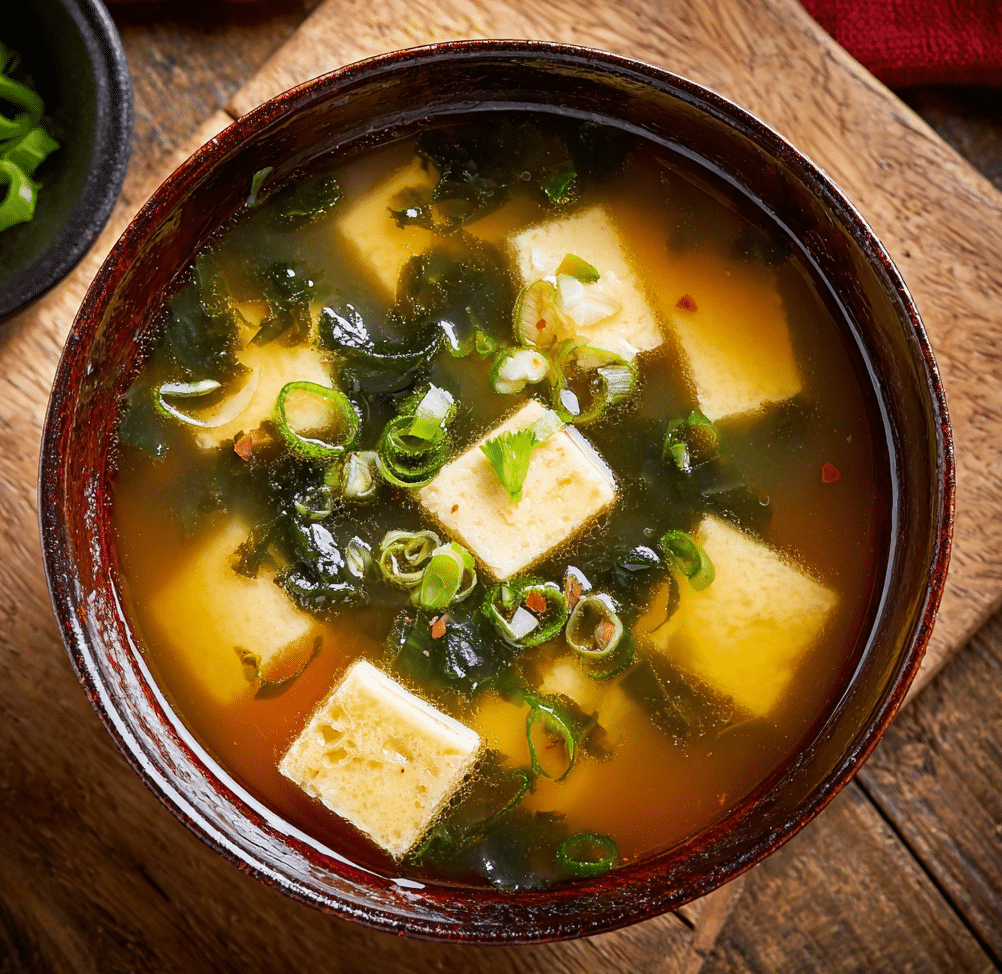The art of making miso soup lies in its delicate balance of umami, simplicity, and nourishing depth. This traditional Japanese dish uses just a handful of ingredients—dashi, miso paste, tofu, wakame, and green onion—but creates a layered, comforting flavor that’s both warming and wholesome.
A staple in Japanese cuisine, miso soup is often served at every meal, symbolizing comfort and home. Whether you’re looking for a light appetizer or a soothing side dish, this miso soup recipe is a fast and flavorful way to experience authentic Japanese flavors. Enjoy it on a quiet night in or as a thoughtful addition to a larger Japanese spread.
Full Recipe
Ingredients:
-
4 cups dashi (Japanese soup stock)
-
3 tablespoons miso paste (white or red)
-
½ block soft tofu, diced into small cubes
-
2 tablespoons dried wakame seaweed
-
2 stalks green onion, finely sliced
Directions:
-
In a saucepan, heat the dashi over medium heat until just before it reaches a boil.
-
While the dashi heats, soak the dried wakame in water for 5–10 minutes until it expands, then drain well.
-
Add the tofu cubes and wakame to the hot dashi and reduce the heat to low.
-
Place the miso paste into a small bowl. Ladle in a bit of the hot dashi and whisk until the miso dissolves completely.
-
Stir the miso mixture back into the pot gently. Do not let the soup boil after adding the miso, to preserve the probiotics.
-
Turn off the heat, add the sliced green onions, and serve immediately.
Prep Time: 5 minutes | Cooking Time: 10 minutes | Total Time: 15 minutes
Kcal: 50 kcal | Servings: 4 servings
The Heart of Japanese Cuisine: Miso Soup
Miso soup is more than just a side dish in Japanese cuisine—it is a cultural symbol, a comforting daily ritual, and a representation of Japan’s time-honored culinary philosophy. Often served as part of breakfast, lunch, or dinner, miso soup is an essential component of the traditional Japanese meal (ichiju-sansai), which emphasizes balance and harmony in both nutrition and flavor. Despite its simplicity, this soup embodies the profound respect Japanese culture holds for nature, fermentation, and mindful preparation of food.
Understanding the Key Elements of Miso Soup
At its core, miso soup is composed of five main elements: dashi (soup stock), miso paste, tofu, wakame seaweed, and green onions. Each of these ingredients carries deep culinary significance. Dashi, made from kombu (kelp) and katsuobushi (bonito flakes), forms the umami-rich base of the soup. Miso paste, a fermented soybean product, contributes a savory depth with subtle variations depending on the type used—white (shiro), red (aka), or mixed (awase). Tofu offers protein and a soft texture, while wakame adds a slightly chewy consistency and a touch of oceanic flavor. Lastly, green onions brighten the dish with a fresh and mildly sharp contrast.
The Cultural Significance of Miso Soup
Miso soup is intimately woven into Japanese daily life. It is often the first dish that comes to mind when one thinks of home cooking in Japan. Many families have their own methods and preferences when preparing it, passed down from one generation to the next. It is not uncommon to hear someone describe a mother’s miso soup as the ultimate comfort food, unique and irreplaceable. This emotional connection highlights the dish’s role not just as nourishment, but as a cornerstone of familial identity and tradition.
Moreover, miso soup is steeped in symbolic meaning. In traditional Japanese wedding ceremonies, for instance, a shared bowl of miso soup represents unity and the beginning of shared life. It is also believed to promote longevity, thanks to its fermented ingredients and overall nutritional value. In fact, many centenarians in Japan report consuming miso soup regularly, crediting it for contributing to their long and healthy lives.
Types of Miso and Their Impact on Flavor
The flavor profile of miso soup can vary greatly depending on the type of miso paste used. Shiro miso (white miso) is the mildest and slightly sweet, often preferred in western Japan. Aka miso (red miso) is aged longer, has a stronger, saltier flavor, and is commonly used in eastern regions. Awase miso, a combination of white and red miso, is a versatile option that balances both flavors and is widely used across Japan.
The variety of miso chosen affects not only taste but also the nutritional properties of the soup. All miso types contain probiotics from fermentation, which can benefit digestion and gut health. They are also rich in B vitamins, essential minerals, and protein.
Versatility and Seasonal Adaptations
While the base ingredients of miso soup remain consistent, it is a dish that easily adapts to the seasons. In spring, fresh bamboo shoots or young greens may be added. Summer versions might include lighter vegetables or chilled tofu. During autumn and winter, hearty additions like root vegetables, mushrooms, or even clams can make the soup more substantial and warming.
This adaptability ensures that miso soup never feels repetitive, even when enjoyed daily. It is also an excellent way to reduce food waste, as leftover vegetables or small amounts of protein can be added to the soup with ease.
Nutritional Profile and Health Benefits
One of the most appealing aspects of miso soup is its health profile. Low in calories yet high in nutrients, it is an ideal choice for those seeking a light but nourishing addition to their meals. The soup provides protein from tofu, iodine and calcium from wakame, antioxidants from green onions, and a range of vitamins and minerals from the miso itself.
Fermented foods like miso are known to support gut health by promoting the growth of beneficial bacteria. Additionally, the soup’s naturally occurring glutamates from dashi and miso enhance satiety and satisfaction, making it an excellent dish for mindful eating.
However, it is worth noting that miso soup can be high in sodium, depending on how much miso paste is used. Individuals monitoring their salt intake may opt for low-sodium miso or reduce the amount of paste slightly while still enjoying its benefits.
The Importance of Not Boiling Miso
One of the key techniques when making miso soup is to avoid boiling the soup after adding miso paste. Boiling miso not only dulls its flavor but can also destroy the beneficial probiotics formed during fermentation. Instead, the miso is dissolved in a small portion of hot dashi, then stirred gently back into the soup just before serving. This mindful preparation method reflects the Japanese respect for preserving the integrity of natural ingredients.
Serving Suggestions and Pairings
Miso soup is traditionally served as part of a full meal that includes rice, a main dish (such as grilled fish), and a few side dishes like pickles or simmered vegetables. However, it also pairs well with modern meals. It makes a great light starter before sushi, rice bowls, or noodle dishes like udon and soba. For a more filling variation, some might add sliced mushrooms, daikon radish, enoki, or even noodles to the soup.
Because it’s so easy and quick to make, miso soup is also perfect for busy weekdays or when you’re craving something comforting but light. Many people prepare a batch of dashi in advance and store it in the refrigerator, making it possible to whip up fresh miso soup in minutes.
Variations Around the World
While miso soup is firmly rooted in Japanese tradition, its influence has spread globally. In many parts of the world, it has been embraced by those following plant-based or whole-food diets. Creative versions now include additions like kale, edamame, quinoa, or shiitake mushrooms. Some even use vegetable broth instead of dashi to create a vegan base. These global interpretations show how versatile and appealing miso soup has become, adapting to local tastes while retaining its core identity.
Conclusion
Miso soup is a beautiful example of simplicity meeting depth in the culinary world. From its rich umami flavor and healing warmth to its impressive nutritional benefits and cultural importance, this humble bowl of soup is a testament to the elegance of Japanese cooking. It’s easy to prepare, endlessly adaptable, and a thoughtful way to include more fermented foods into your daily diet.
Whether you’re discovering miso soup for the first time or returning to it as a familiar favorite, each spoonful invites you into a tradition that spans centuries. It’s a dish that encourages mindfulness, nourishes the body, and connects us to the deeper essence of food as both sustenance and story.
By incorporating this time-honored recipe into your culinary repertoire, you not only enjoy a flavorful and comforting dish but also pay homage to the principles of harmony, respect, and wellness that define Japanese cuisine.






